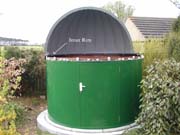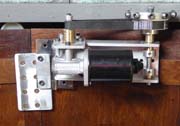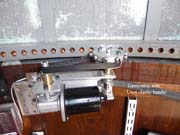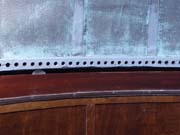The Rigel system uses rubber rollers pinching an inner extended rim of the Pulsar dome. But my dome has a solid wooden rim as shown here in this photo from the original installation. As always click on the thumbnail for a larger photo.

Please note, some of the links will open in a new page - I use frames, and some links don't work directly.
As the result of a conversation on the UKAI imaging group, I decided to have a go at fitting some form of drive unit to my Observatory. Particularly when imaging with the 10" telescope (and even more so with my previous 12" one) I have to move the dome round every 30 to 40 minutes to keep the slot in line with the telescope. As I usually monitor the imaging progress from my computer in the house (using TeamViewer) this was a bit of an onerous duty, particularly in very cold weather, and occasionally overlooked with potential loss of images.
Because of the way the dome is constructed, the readily available units such as the Rigel system from Pulsar Observatories were not suitable. And quite expensive bearing in mind that mine is now 13 years old and feeling its age a bit, so perhaps not worth spending a lot of ££s!
Suggestions and encouragement from Chris Bailey on the UKAI group steered me in a suitable direction - many thanks, Chris.
Chris mentioned using a windscreen wiper motor to drive the dome, and I came across two possible methods, one using a toothed belt fixed to the rim, the other using an 'Acorn Wheel'. Because my dome needs quite a shove to move it, I considered that the toothed belt might be prone to jumping. Lubrication of the bearing wheels helped to ease that a bit, but a long enough belt was going to be pricey, so I decided on the acorn wheel approach. Here is a system using that method . The commercially available wheel and strip from Explora-dome again was quite expensive, and I was also concerned that a windscreen wiper motor might not have sufficient power at low speeds to drive even the 6" wheel.
But again my browsing turned up this link which gave me the idea to use a toothed belt to reduce the speed of the wiper motor which ran at almost 100 RPM at full no load speed - far too fast as you will have seen in the acorn drive video above.
The motor speed needed to be controllable, and to obtain the very slow near sidereal speed would only be pulsed for a few seconds every 10 minutes or so. Electronic bits were needed for that, and were readily available. This is the speed controller, and this the interval timer. Both remarkably good value and available from various sources on eBay. I'll keep an eye on the links and correct them if necessary!
|
Then the work really started. Drive pulleys and belt sizes researched, ordered and delivered from Belting on Line - a very comprehensive site and excellent service. Much head scratching, but eventually arrived at this assembly, fitted to the dome wall. Still needed holes drilling and some form of tensioning. The toothed belt ratio is 14 to 72 teeth i.e. 5.14:1. The driven wheels are held on their shaft by stepping the shaft with a nut on top, so although the shaft rotates in its bushes, it's not actually doing any driving. For anyone working with toothed belts, there is a handy belt length calculator here. The pulleys and belt I eventually used (Belting on Line references) are: 1 x 14 Tooth HTD3 Pulley (14-3M-15F) (HP14-3M-15F) What looks like a bush between the driven wheel and the frame is actually a spacer with a very small clearance. Just there in case the lower shaft collar slips. The brass bushes for the main shaft are pressed into the frame. But if they slacken and start to turn in future I'll use grub screws to fix them. Slightly confusing in the photo, but the acorn wheel and large toothed wheel are bolted together - one of the two bolt heads is directly in front of the shaft nut in the photo. The motor mounting plate has a slotted hole for the bolt nearest the main wheel, for belt tensioning, and the hinge holes under the clamping plate are enlarged to enable final adjustments for level and height. |
 |
|
So with all the 264 holes drilled (I did an initial test with a smaller number!) I was able to run the drive in earnest. And I'm pleased to say all was well! This is a close up of the drive in running position, and a video here (5.75MB mp4). The creaking noise is just that - the wooden dome flexing a bit as it rotates. Nowhere near as bad as it sounds in the video. The motor runs faster in reverse than forward - just a feature of the motor, probably slight misalignment of the brushes, but nothing I can do about it, and not a problem. At maximum forward speed the dome does a full revolution in about 1 3/4 minutes, a bit faster in reverse. |
 |
After a year of use the system still runs smoothly and reliably with no appreciable wear to the dome rim. And dome repairs (below and on the foot of the main Observatory page) seem to be doing the job with occasional attention to paintwork. So hopefully all will be well for several years.
Repairs
|
The next day, after giving the repair a chance to fully cure, it was a matter of final sanding to profile, re drilling the holes for the drive and giving it a coat of paint. Also of course the plastic sheeting was re fixed. Hopefully with a more comprehensive external repaint over the Summer this particular problem will not return. I still had the final jig for the hole drilling, which matched up perfectly with the old holes, and the drive runs happily over the repaired section. Disaster postponed, with any luck for a few more years. But see the foot of the main Observatory page re damage...... |
 |